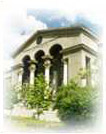I doubt if the ACed program is right I have been thinking about the problem these days, and found that the solution is much related to the 4, 5 or 6-point groups of the N points.
For the former two situations, we could simply calculate that the total number of the figures is
4 * C(n, 4)
and
5 * C(n, 5)
but what have we do when there are 6-point groups? According to the problem statement, the chords must intersect pairwise, so the solution for 6-point groups will be based on the detail position of the points. For example, we must find out if the chords will parallel with each other.
On the other side, I found we have more than one ways to connect 6 points to form the figure. For those 6-point groups with no paralleling chords, we have actually 4 ways to connect them: (1-4, 2-5, 3-6), (1-4, 2-6, 3-5), (2-5, 1-3, 4-6) and (3-6, 1-5, 2-4). Here we numbered the points in CW or CCW order.
Could anybody tell me that why the correct answer could be
4 * C(n, 4) + 5 * C(n, 5) + C(n, 6), (especially the last term)
If my analysis above is right, this formula will be wrong even in N = 7.
Thanks in advance. Why isn't 259 the answer for N=7? I think that's indeed the correct answer.
For any 4-point group we have 4 combinations, and for any 5-point groups we have 5. So there are
4 * C(7 ,4) + 5 * C(7, 5) = 245.
For any 6-point groups, as N = 7, we could know that it is a complete group for all 7 points with only one missing. So the 7 "different" groups are actually the same.
Let's count how many interesting triangles in one group. For they are all the same, we take point 1, 2, 3, 4, 5, 6 on the circle, which is in CCW order (7 is missing).
We have the following two ways to connect them and make them intersect pairwise:
(1-4, 2-5, 3-6): a small triangle is formed inside the circle.
and
(1-3, 2-5, 4-6): a long triangle is formed, with 2 of its vertices inside the circle.
So, there are 2 (or, at least 2) combinations for every 6-point groups in N = 7. So the total number will be
245 + 7 * 2 = 259
(or, at least 259). But all the ACed program will give the answer 252.
Why? Where did I have a mistake? Anyone, please, tell me the truth about this problem.
Thanks again in advance! Re: I doubt if the ACed program is right 3 of your ways to connect 6 points are wrong:
(1-4,2-6,3-5) - segments 2-6 and 3-5 don't intersect
(2-5,1-3,4-6) - segments 1-3 and 4-6 don't intersect
(3-6,1-5,2-4) - segments 1-5 and 2-4 don't intersect
It is true, because any six different points construct a CONVEX 6-gon if they lie on one circle. Re: I doubt if the ACed program is right Well, I suddenly realized that we should regard the CHORD as a SEGMENT, not a LINE. So the ACed programs are right.
Thank you very much. |
